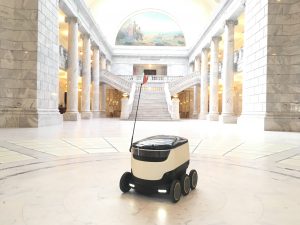
SALT LAKE CITY — A bill that would increase access for personal delivery robots is waiting for approval by the Utah House.
HB217 would allow the devices access to sidewalks and crosswalks in Utah, where they are currently prohibited. A House committee approved the bill on Jan. 31.
David Catania is a lobbyist for the leading producer of the machines: Starship Technologies — a growing European company founded by the same people who created Skype.
Catania said the robots are “like an Uber for things.”
The devices are activated by a mobile app like Lyft or Uber using GPS technologies. When an order is in transit, the company texts the customer, who can track the order via the app.
Inside the robot is a compartment about the size of a beverage cooler. With a speed of 4 mph, the machines can deliver within a 3-mile range and carry up to 20 pounds, which is equivalent to two to three bags of groceries.
Catania demonstrated in the House the machine’s use of artificial intelligence technology and proprietary software, which allow the machine to avoid obstacles and “see” its surroundings, thus maximizing safety.
“It will stop if you are in front of it; it will slow down if you are next to it,” Catania said. “We have seen great progress.”
Currently, the companies that use the devices are mostly parcel and food delivery companies. In Europe, Dominos Pizza is the biggest user of the device, according to Rep. Stuart Barlow, R-Fruit Heights, who is sponsoring the bill in the House.
However, Starship is considering ways to aid visually impaired people in the future. Catania mentioned the device could replace seeing eye dogs, which can cost up to $7,000.
During the House committee hearing, Catania explained the robots can be used to deliver medical supplies, like diabetes test strips, to patients.
These personal delivery devices are hardly new, Catania said. Starship has a total of 150 machines around the world. The robots have had 11 million human interactions so far involving loading and receiving products.
“They are certainly far cheaper, more efficient (and) use less energy than the current delivery options,” Barlow said. “They are electric powered; they emit zero carbon dioxide.”
Five states in the U.S. have passed legislation to permit these delivery bots access to crosswalks and sidewalks, including Washington D.C., where they are now operative.
Rep. Walt Brooks, R-St. George, spoke about the difficulty of the last leg of delivery, called “the last mile,” in reference to the bill. The last mile speaks of getting products to the consumer. It takes time and money for consumers to travel to the stores and find the products they need, but the robots change the process.
“I think it’s important for the community to know … the last mile is the most difficult and the most expensive and these devices are what overcomes that,” Brooks said.




